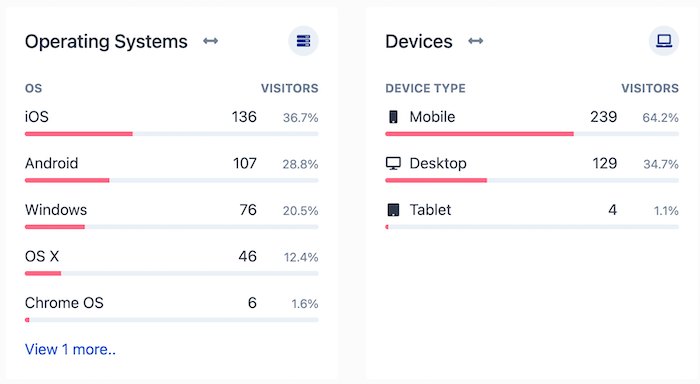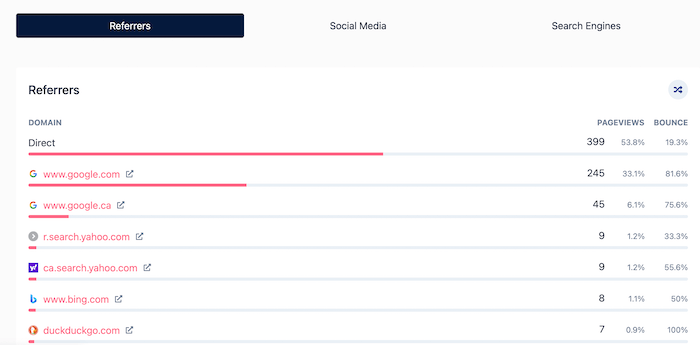Monitoring website analytics is essential as it helps you measure the success of your business goals. Moreover, it enables you to develop more effective strategies and understand how to improve the user experience.
This complete guide will show all you need to know about website analytics. We will also introduce an excellent free site analysis tool. So let’s waste no time and get started.
Related Article: Mobile Analytics: From Why to How
What Is Web Analytics?
First, let’s start with the definition of website analytics. Website analytics is the process of collecting and analyzing a website’s data to measure its effectiveness. The process enables you to understand your target market better to optimize your website. It also helps you measure the performance of your marketing campaigns.
Web analytics software provides you with information like the number of visitors, page views, session length, etc. Businesses use this type of software to find out how to improve their CRO strategy.
Why Website Analytics Is Important
You can gain invaluable information about your website visitors’ behavior and boost business growth with website analytics.
Here are some reasons why you must perform website analysis:
1- Delivering Better User Experience
88% of visitors are less likely to return to a website with a poor user experience. Website analytics give you insights into how to improve the user experience on your website. It helps you understand how visitors interact with your pages so you can remove frictions.
For example, you can see what devices and operating systems your visitors use. This way, you will know what devices you should consider when designing your website.

You can also see which countries your visitors are from and their browsing languages. Therefore, you can personalize your website for visitors from different countries.

By improving the user experience, you can increase user engagement on your website, which leads to more conversions.
2- Improving Your Content
Using a website analyzer tool, you can determine which content on your website attracts more attention. Then you can focus more on that type of content and stop wasting time creating the wrong content.
You can track the number of visitors and the bounce rate for each web page. This information helps you optimize these pages to engage visitors more effectively.
Your pages with top-performing content are an excellent opportunity to increase your conversion rate. For example, you can add CTAs, promotional links, lead magnets, etc.

3- Improving Your Website’s SEO
Search engine optimization has many benefits for your business, including increasing brand visibility, boosting credibility, and improving ROI. Also, in some cases, more traffic means more leads and conversions.
Monitoring web analytics is an excellent way to figure out how to improve your website’s SEO. Website analytics services give you access to demographic information, which helps you create more targeted content to boost your ranking.
4- Identifying High-Performing Traffic Sources
Website analytics tools also allow you to track your referrals, the websites that send traffic to your website. Hence, you can see which sources send the most traffic to your website. For example, if you are driving a good amount of traffic from social media, it means your social media strategy has been effective.

5- Tracking Conversions
Conversion rate is one of the most crucial website performance metrics you should be tracking. Web analytics software allows you to track the conversions on your website. By monitoring your conversion goals, you will develop more effective conversion rate optimization strategies.

Website Analytics Best Practices
Now it’s time to take a look at some of the website analytics best practices:
1- Create a Data-Driven Culture
Creating a data-driven culture enables you to make more informed business decisions based on the data you have collected. It helps you capture and use meaningful data effectively to understand how to improve your business. With a data-driven culture, you can ensure continuous improvement by constantly monitoring your performance.
2- Web Analytics Is More than Measuring Your Traffic
Remember that website visitor analytics isn’t just about measuring your traffic. It’s also an excellent way to understand your target market better and improve your website accordingly.
Website traffic reports only include data like visits, pageviews, top-performing sources, and most popular pages. Unfortunately, this data can put you on the wrong track if you are not considering other important metrics. For example, you might have 3 million visitors per month and think, “Wow! That’s great!” But would it really matter if you have a low conversion rate?
3- Focus on the Long-Term
Don’t just focus on your data within a specific timeframe. You need a long-term understanding of your website’s performance and visitors’ behavior. Therefore, you can better evaluate your website and how visitors interact with it.
4- Draw Insights from Your Data
Data is useless without actionable insights. That’s why you must turn data into insights to take action.
Use the data to identify your website’s strengths and weaknesses and the areas that need improvement. So, you can set clear goals for improving your website.
Related Article: How to Get Data-Driven Insights for Your Website?
5- Learn the Capabilities of Your Website Analytics Tool
You need to fully understand how the website analytics platform you are using works. Make sure to take the time to learn everything about the tool, including its features and capabilities. This is necessary to get the most out of your web analytics software and obtain accurate data.
You won’t make smart decisions without precise information, leading to marketing failure.
Most Important Website Analytics Metrics
There are many website analytics metrics that you can track. Here we will discuss the most important ones.
1- Bounce Rate
Bounce rate is the percentage of people who visit a webpage on your website and leave it without taking any action. Typically, a lower bounce rate is better because it means visitors are interacting with your website.

If you have a web page with a high bounce rate, you can improve your content or add a CTA to encourage action.
2- Conversion Rate
Conversion rate refers to the percentage of visitors who complete a desired goal on your website. Calculating and tracking the conversion rate is crucial for measuring your website’s performance, as the goal is to encourage more visitors to take action.
Creating a customer journey map is a great way to understand how to lead more visitors to take action.

If you want to know more about this metric, you can read this article: What Is Conversion Rate (CR): The Complete Guide.
3- Average Time on Site
average. If people spend little time on your website, it might mean they can’t find what they’re looking for easily.
It’s a good idea to identify the correlation between your conversion rate and average time on site. For example, if you have a high conversion rate, maybe there’s no need to increase the average time on site.

4- Referrers
This metric shows you which websites are sending traffic to yours. These are websites that include links to your website, and visitors click on them. Knowing which websites are your high-performing referrers helps you better understand your target market.
Moreover, it provides a great opportunity to take your link-building to the next level. You can also take advantage of these websites to improve your advertising and guest blogging efforts.
5- Pageviews
This metric indicates the total number of viewed pages on your website. More page views mean your content is getting more visibility.
You can find out how many people have visited a single page on your website, which gives you helpful insights into your traffic.
How Do I Get Website Analytics?
So now you might be asking how to check website analytics. The answer is you need to use web analytics services.
You can use a tool like Google Analytics for your website; however, it comes short compared to platforms that offer qualitative research tools along with site analysis. That’s why we will introduce a free website analytics tool, WatchThemLive, that provides more than numerical data.
In the next part of this guide, we’ll explain how to get started with this tool to analyze websites. So read on.
FAQs about Website Analytics
What Are the Most Important Website Analytics?
There are plenty of website analytics metrics out there, but you should only focus on the ones that help you achieve your goals. Some businesses only monitor website traffic analytics; however, you should also track conversion metrics to see if you are getting any results.
Another important metric you should track is pageviews to find out your most popular content and visitors’ intent.
Additionally, make sure to keep an eye on your bounce rate. If you have a high bounce rate, try to know your visitors better to deliver more relevant experiences. You might also want to determine if you need to redesign your website to make it more user-friendly or create more compelling CTAs.
How Often Should You Check Website Analytics?
The answer to how frequently website analytics should be checked varies for each website. It depends on the amount of your website’s traffic and how often you publish content.
Generally speaking, it’s good to monitor your web analytics once a week.
What Are Website Analytics Tools?
Website analytics tools are tools that enable you to track website activity. These tools help you better understand what’s happening on your website and measure its performance. The insights these tools provide can help you improve the user experience to boost conversions.
What Are the Best Website Analytics Tools?
Google Analytics is a common website analytics tool; however, using tools such as Watch Them Live that enables qualitative data analysis can provide more tangible results.
